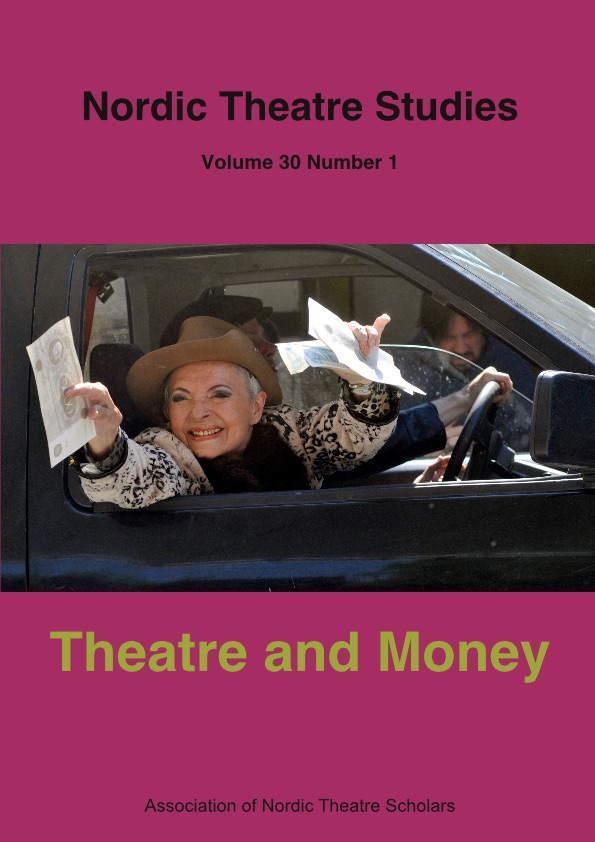Performance-in-Business
Armi Ratia’s Marimekko
DOI:
https://doi.org/10.7146/nts.v30i1.106928Keywords:
Performance-in-business, cleft, theatricality, innovation, workAbstract
My article, “Performance-in-Business: Armi Ratia’s Marimekko”, examines what happens to artistic performance in the concept of arts-in-business. In theatre and artistic performance, artistic thinking has traditionally been considered primary over economic thinking, but in arts-in-business the goal has been economic. The concept of arts-in-business, created in the 2000s, involves the strategic use of artistic elements in business in order to develop the creativity, problem-solving abilities, and innovativeness of employees as well as the brand of the business company. I will analyze the use of theatre as part of two historical forms of arts-in-business, the Bauhaus movement in Germany from 1919 to 1933, and the 2000s concept of arts-in-business. Regarding the latter, I will draw meanings from Lotte Darso’s (2004), Giovanni Schiuma’s (2011), and Jon McKenzie’s (2001) research on performance in business. After initiating a dialogue between these two approaches, I will provide a new theory for arts-in-business and apply it to Marimekko’s business practice. McKenzie (2001), as well as other studies of arts-in-business in the 2000s, does not emphasize the role of the manager-as-an-artist. In this article, I claim that only if the manager initiates artistic practice and the arts are interrelated to the product, can the arts penetrate the whole enterprise because of the role of managers in making constitutive decisions for the business. I will argue that some managers are able to do this. Ratia’s Marimekko is my exemplary case. As the key concept of my new theory of performance-in-business I employ performance scholar Josette Féral’s (2002) cognitively-oriented theory of theatricality based on the concept of a cleft and its variants in other theories. In the last section of this article, I will examine the Finnish fashion design company, Marimekko, under the management of Armi Ratia, as a business that employs the theatricality of clefts.
References
Aronson, Arnold. 1991. “Postmodern Design.” Theatre Journal 43, 1–13.
Carlson, Marvin. 2004. Performance: a Critical Introduction. Second Edition. New York and London: Routledge.
Carlson, Marvin. 1993. Theories of the Theatre: A Historical and Critical Survey, from the Greeks to the Present. Expanded Edition. Ithaca and London: Cornell University Press.
Corbett, Natalie. 2009. “Digital Performance, Live Technology: Video Games and the Remediation of Theatrical Spectatorship”. In Performing Adaptations. Essays & Conversations on the Theory and Practice of Adaptation. Eds. Michelle MacArthur, Lydia Wilkinson and Keren Zaiontz. Cambridge: Cambridge Scholars Publishing.
Darso, Lotte. 2004. Artful Creation. Learning-Tales of Arts-in-Business. Frederiksberg: Samfundslitteratur.
Design by Caleb: Apple and the Bauhaus. http://www.designbycaleb.com/2015/05/08/apple-and-the-bauhaus/
Donner, Jörn. 1986. “Unelmat ja todellisuus”. In Marimekkoilmiö. Eds. Hilkka Rahikainen-Haapman, Eeva Kaarakka and Marja-Terttu Vuorimaa. Espoo: Weilin + Göös.
Feral, Josette. 2002. “Theatricality: The Specifity of Theatrical Language.” Substance # 98/99, Vol. 31, nos 2 & 3.
Fischer-Lichte, Erika. 2008. The Transformative Power of Performance. A New Aesthetics. London and New York: Routledge.
Forgács, Eva. 1995. The Bauhaus idea and Bauhaus Politics. Budapest; New York: Central European University Press; Distributed by Oxford University Press.
Gray, Laura. 2011. Steve Jobs: Billion Dollar Hippy. A Documentary film. 50 min. Directed by Laura Craig and Tristan Quinn. UK: BBC.
https://www.youtube.com/watch?v=0FoTFal0KAA
Gummerus, Erika 2003. Interview with Marja-Leena Parkkinen 2 July 2003. Parkkinen’s private archive.
Herman, David. 2002. Story Logic. Problems and Possibilities of Narrative. Lincoln & London: University of Nebraska Press.
Hyvärinen, Matti. 2010. “Eletty kertomus ja luonnollinen narratologia”. In Luonnolliset ja luonnottoman kertomukset. Jälkiklassisen narratologian suuntia. Eds. Mari Hatavara, Markku Lehtimäki and Pekka Tammi. Helsinki: Gaudeamus.
Karsi, Anneli. 1995. Marimekon yrityskulttuuri. Designed by Armi Ratia. Saarijärvi: Gummerus.
Koestler, Arthur. 1976. “Association and Bisociation.” In Play. Its Role in Development and Evolution. Eds. Jeremy Bruner, Alison Jolly and Kathy Sylva. Harmondsworth, Middlesex: Penguin Books.
Koivuranta, Esa, Kati Pehkonen, Tuija Sorjanen, Annina Vainio and Nina Karlson. 2015. Marimekko: suuria kuvioita. Helsinki: Into.
Lehikoinen, Kai, Anne Pässilä, Mari Martin and Maiju Pulkki (eds.). 2016. Taiteilija kehittäjänä. Taiteelliset interventiot työssä. Helsinki: Teatterikorkeakoulu.
Lyotard, Jean-Francois. 1984. The Postmodern Condition: A Report on Knowledge. Trans. Geoff Bennington and Brian Massumi. Foreword by Frederic Jameson. Manchester: Manchester University Press.
McKenzie, Jon. 2001. Perform or Else: From Discipline to Performance. New York and London: Routledge.
Mäkelä, Maria. 2010. ”Medialukija romaanin opissa. Tapaus Clinton–Lewinsky ja kirjallisesti välittynyt kokemuksellisuus”. In Luonnolliset ja luonnottoman kertomukset. Jälkiklassisen narratologian suuntia. Eds. Mari Hatavara, Markku Lehtimäki and Pekka Tammi. Helsinki: Gaudeamus.
Norman, Donald. 2005. Emotional Design. Why We Love (or Hate) Everyday Things? New York: Basic Books.
Ojala, Esa 2003. Interview with Marja-Leena Parkkinen 31 July 2003. Parkkinen’s private archive.
Parkkinen, Marja-Leena. 2005. Love Armi. Armi Ratian henkilökuva. Helsinki: Otava.
Ratia, Risto-Matti. 2002. Paha poika. Helsinki: Otava.
Saarikoski, Tuula. 1978. Armi Ratia. Legenda jo eläessään. Helsinki: WSOY.
Schiuma, Giovanni. 2011. The Value of Arts in Business. Cambridge, New York: Cambridge University Press.
Sydänmaanlakka, Pentti. 2009. Jatkuva uudistuminen. Luovuuden ja innovatiivisuuden johtaminen. Hämeenlinna: Talentum.
Vattimo, Gianni. 1992. The Transparent Society. Cambridge: Polity Press.
Vihma, Susann. 2011. “Kaj Franck, modernism ynnä muuta muotoilun historiasta”, Tieteessä tapahtuu 8/2011, 19–23.
Whitford, Frank. 1984. Bauhaus. London: Thames & Hudson.
Downloads
Published
How to Cite
Issue
Section
License
The copyright belongs to the authors and Nordic Theatre Studies. Users can use, reuse and build upon the material published in the journal but only for non-commercial purposes. Users are allowed to link to the files, download the files, distribute the files on a local network (preferably by links), upload the files to local repositories if their institutions require them to do so, but not republish the files without proper agreements with the journal and the author.

